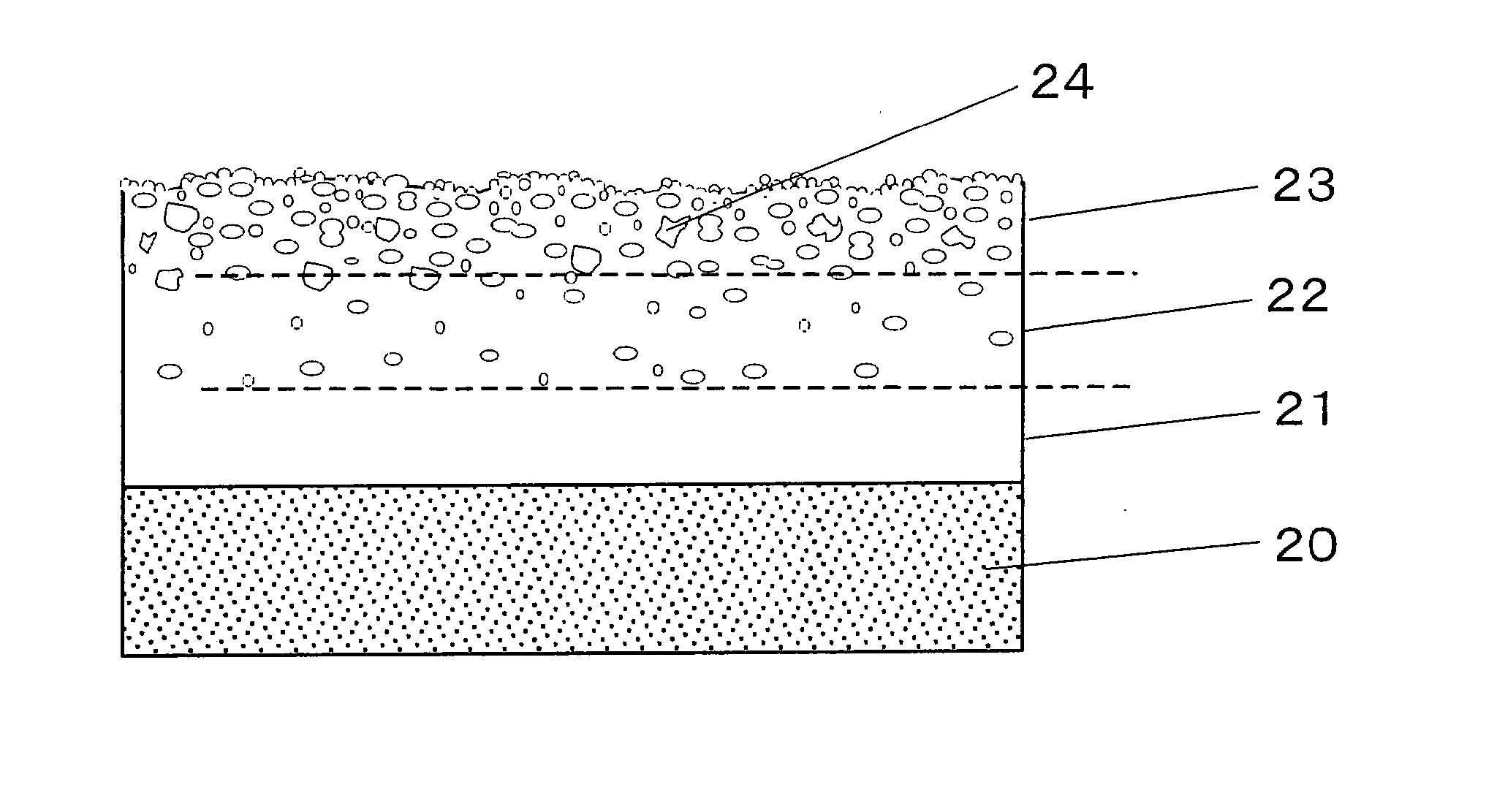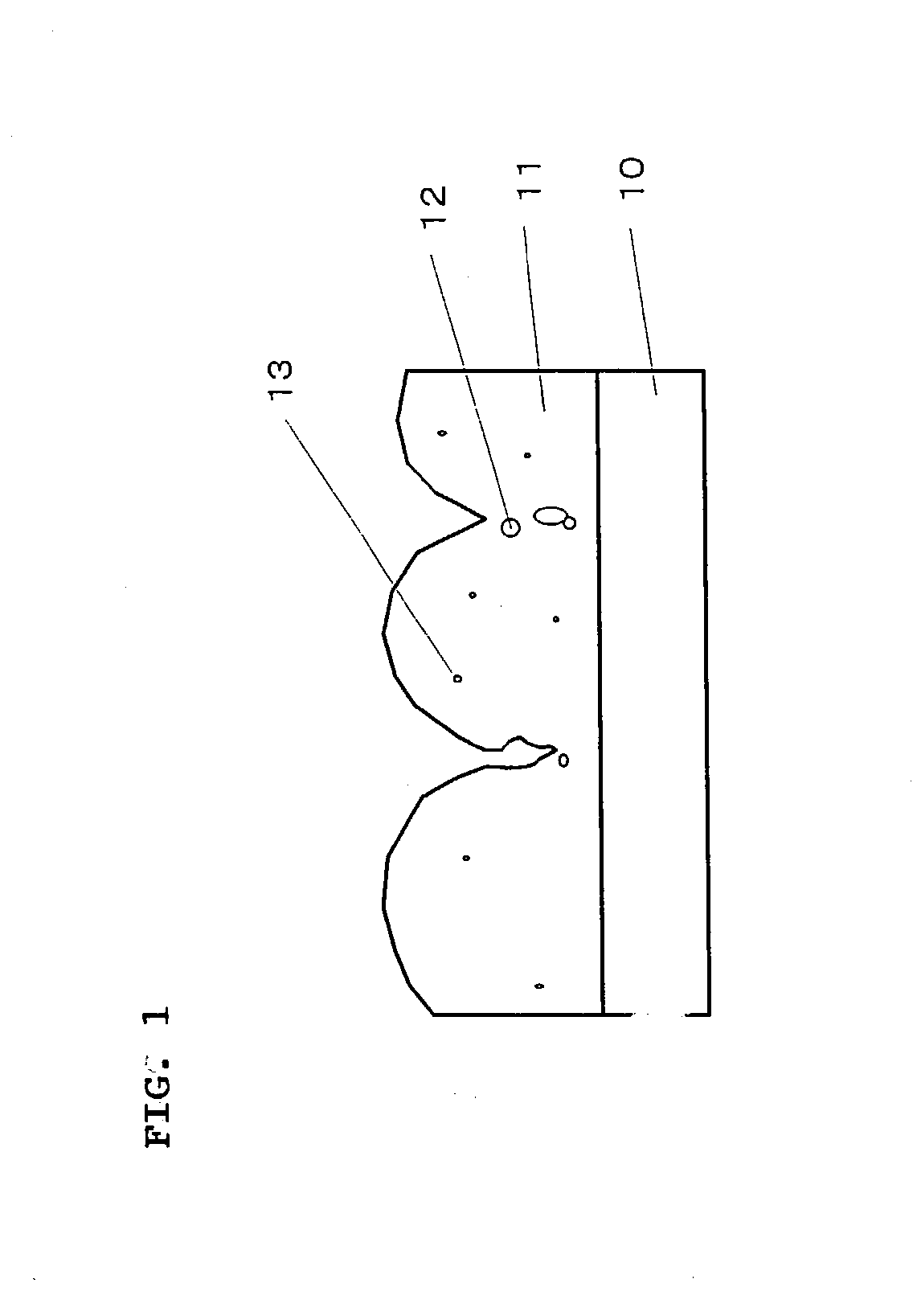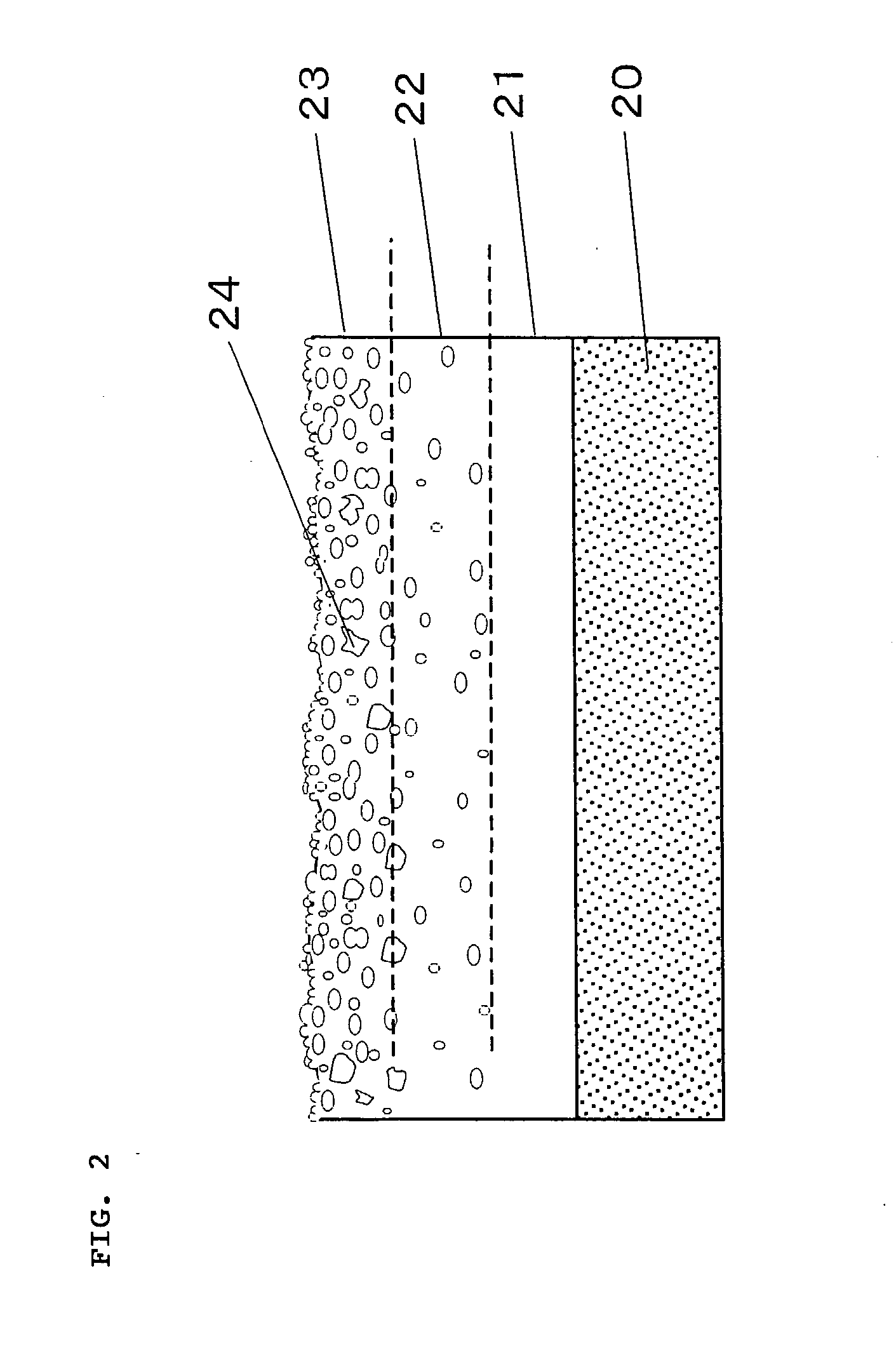In forming a film of polysilicon,
silicon nitride,
silicon oxide or the like on a film substrate in the production of semiconductors and others, the problem often occurred that the film deposits on not only the film substrate but also the
machine parts such as reactor tubes, bell jars, etc.
The deposited film on the
machine parts increases its thickness through repetition of the film-forming operation, thereby the parts crack due to the difference in
thermal expansion between the deposited film and the parts, or the deposited film may peel away from the parts to pollute the area inside the
machine.
However, in case where the deposited film is difficult to remove through treatment with
hydrofluoric acid and when the parts are readily corroded with
hydrofluoric acid (e.g., quartz glass parts), the method is the problem that the parts themselves are further corroded on the area thereof in which the deposited film is partially lost through washing with
hydrofluoric acid, and as a result, the parts further deteriorate.
However, the parts with a film of Mo, W, Al, WC,
alumina or the like formed on a substrate still have the problem that the film itself readily peels off.
In addition, in the technical field in which quartz is used for the substrate, the
coating composition for the film is unfavorable as causing impurities, and therefore it has been often reluctant to use those films.
However, the quartz glass parts processed through blasting have mircocracks on the roughened surfaces thereof, and the fragments of the parts that start from the microcracks thereof become impurities in devices.
Another problem in the parts is that their life is short since their
mechanical strength is low, and impurities readily penetrate into the microcracks to devitrify the parts.
The problem of fragmentation to give impurities could not still be solved even though blasting is combined with
acid etching for
processing the parts.
Therefore, repeatedly washing the parts has the problem that their ability to hold the deposited film thereon lowers.
However, the parts of this type have the problem that their surfaces are liable to be smoothed through
acid washing and their ability to hold the deposit thereon readily lowers.
In case where quartz glass is used for parts (e.g., core tubes) of
thermal treatment devices, there is the problem that the
thermal energy inside the devices may leak out to lower the
thermal efficiency of the devices since quartz glass is highly transparent.
However, such still has the problem that its adhesiveness (sealability) to other parts in their bonding area is not good since the bubbles may be exposed out on the surface of opaque quartz glass to worsen the
surface smoothness of the glass.
However, the porous opaque quartz glass has the problem that the sealability of the
flange formed of it is not good since the bubbles may be exposed out on the surface of the glass.
Another problem is that when the parts formed of porous opaque quartz glass are washed with
nitric acid / hydrofluoric acid or the like after use, their
surface smoothness is greatly lowered and they soon become useless.
However, the parts thus fabricated by
welding a transparent
glass sheet to their flanges formed of opaque quartz glass still have the problem that they are readily cracked and, in addition, the welded part is readily cleaved.
In addition, the
welding operation requires some technical skill and is therefore unsuitable to industrial use.
However, this still has the problem that the transparent quartz glass layer formed on the opaque quartz glass substrate is readily cracked and quartz glass parts having a complicated shape could not be fabricated.
Another problem is that, in the Verneuil's method, since the substrate is maintained at high temperature of 1,900.degree. C. or higher for a long period of time, impurities may diffuse out of the substrate even when the substrate is formed of synthetic quartz glass of high purity, and the purity of the surface of the parts fabricated is thereby lowered.
However, this has also the problem that, when the mechanically-worked surfaces of the sintered quartz glass parts are locally heated, they receive stress and are thereby cracked or cleaved.
However, this method also has the problem that, when such a high-purity quartz
glass film is formed on parts through plasma CVD, its thickness is at most tens .mu.m or so, and the film is therefore not enough to flatten the rough surfaces of the parts formed of opaque quartz glass and to prevent the
diffusion of impurities.
However,
alumina and yttria have the problem as impurities in production of semiconductors as described hereinabove, and they are unsuitable for the
thermal spraying material for parts.
In addition to the problem of sealability as described above, another problem in the oxidative
diffusion treatment devices and CVD devices for use in
semiconductor production is that the
thermal efficiency lowers through thermal diffusion from the devices and the
throughput in the devices is therefore low.
Therefore, the glass must be melted in a
reducing atmosphere or in vacuum, which, however, has the problem that a particular apparatus is necessary for the specific
atmosphere control.
Another problem in the conventional blackened quartz glass is that, when it is used at high temperatures, the
metal element added thereto for blackening it may pollute the area inside the chamber or may crystallize to deteriorate the glass.
However, the problem of deterioration of quartz glass due to
crystallization thereof could not be completely solved by that method.
In addition, the method has another problem that it requires a large-scaled
vacuum furnace and the method itself is troublesome and, in addition, the size of the parts obtainable in the method is limited and the method could not apply to large-sized parts.
However, the method of using
oxyhydrogen flames has the problem that the element added to the glass for blackening it is oxidized and the glass is thereby often vitrified.
In addition, the method could not still solve the problem of
crystallization of quartz glass.
In addition, since the accuracy of the thickness and the width of the thickened layer could not be controlled in the method, the parts fabricated in the method must be mechanically worked in
post treatment and large-sized quartz glass parts are difficult to fabricate in the method.
As described above, the parts of film-forming devices, oxidative diffusion treatment devices, plasma-treating devices and others have many problems that the deposited film thereon peels away to give particles, their ability to hold the deposited film lowers after repeatedly washed with acid, their
surface smoothness is not good therefore causing bonding failure (airtight sealing failure) to other parts, and their energy efficiency is low as their heat insulation is not good.
If its Ra is smaller than 5 .mu.m, the ability of the sprayed substrate to hold the deposited film thereon is not sufficient, and if it is larger than 100 .mu.m, the surface of the coated substrate is too rough and the
mechanical strength of the quartz glass thermal sprayed film formed on the substrate decreases.
Substrates roughened through conventional blasting, especially when the substrate is made of glass, are the problem that they have microcracks and therefore their
mechanical strength lowers.
However, if the
relative density of the film is higher than 95%, the ability thereof to hold a deposited film thereon will become insufficient.
If the
relative density of the first layer of the film is low, it is undesirable since the adhesiveness between the quartz glass thermal sprayed film and the quartz glass substrate is low.
If there exist some pores of 100 .mu.m or larger in the interface between the quartz glass thermal sprayed film and the substrate of the quartz glass thermal sprayed part, the film will peel away from the substrate in the interface therebetween and its durability is not sufficient.
When the quartz glass thermal sprayed film is etched with hydrofluoric acid and when Ra of the thus-etched film is smaller than 10 .mu.m, the ability of the film to hold a deposited film thereon is not sufficient.
If it is smaller than 0.05 mm, the recess is too small and the ability of the thermal sprayed film to hold a deposited film thereon will be poor; but if larger than 1 mm, the surface of the thermal sprayed film is smooth and the ability thereof to hold a deposited film thereon is also poor.
Therefore, even after etched, the ability of the ordinary blasted quartz glass parts to hold a deposited film thereon is still poor.
However, if the film is too thick, the dimensional accuracy of the parts will lower.
If the angle is smaller than 20.degree., the surface of the film will be smooth and the ability thereof to hold a deposited film thereon will be poor.
If the angle is larger than 60.degree., the surface of the film will be too rough and the mechanical strength thereof will be low.
If the film has some bubbles therein, those may be exposed out on the surface of the film to deteriorate the surface smoothness of the film.
However, it is difficult to obtain a film with no bubble at all by
thermal spraying, and it is therefore desirable that the film does not have large bubbles having a
diameter of at least 100 .mu.m.
However, if the film is too thick, the dimensional accuracy of the parts will lower.
This is because, when a quartz glass thermal sprayed film alone is formed directly on a
metal or
ceramic substrate, it may be cracked, cleaved or deformed due to the difference in the
thermal expansion coefficient between the substrate and the quartz glass.
If it is smaller than 5%, the ability of the layer to absorb stress is poor and the layer could not be prevented from
cracking and cleaving and its heat insulation will be unsatisfactory.
On the other hand, if it is larger than 50%, the mechanical strength of the film itself is decreased, which is not desirable.
If the substrate is melted entirely, it is unfavorable since the substrate will be deformed.
During the thermal spraying, the surface of the substrate is locally heated high, and the deformation of the substrate due to
thermal expansion cannot be negligible.
Due to this, the substrate may be cracked or broken.
However, too
fine powder having a mean particle size of smaller than 20 .mu.m may clog spray nozzles and its stable supply in spraying devices will be difficult, and a uniform film is difficult to form from it.
On the other hand, coarse
powder having a mean particle size of larger than 150 .mu.m will form a
porous film, and a dense film is difficult to form from it.
If so, the adhesiveness between the
porous film and the substrate is poor, and the film will be readily peeled.
If the
etching time is too short, formation of dimples will be unsatisfactory; but if too long, the quartz glass film will be dissolved too much and the life of the quartz glass thermal sprayed parts will be thereby shortened.
If the mean particle size of the
silicon nitride powder is smaller than 0.5 .mu.m, the
silicon nitride powder will be difficult to uniformly mix with the spraying powder of quartz; but if larger than 5 .mu.m, the
diameter of the bubbles that may be formed in the thermal sprayed film will be larger than 500 .mu.m and the mechanical strength of the film will be low.
If the amount of the
silicon nitride powder added is smaller than 0.03% by weight, good bubbles could not be formed in the thermal sprayed film; but if larger than 3% by weight, it is unfavorable since the bubbles formed may bond together to be large bubbles and the bubbles could not be uniformly dispersed.
 Login to View More
Login to View More 


